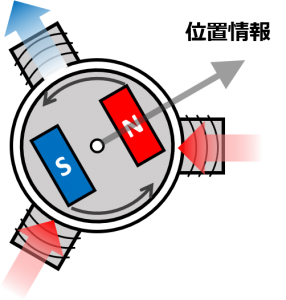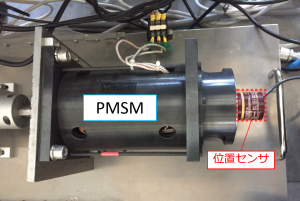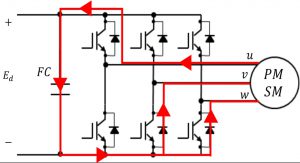
- 名前:
- Hao Rongjiao
- 学年/肩書:
- 博士課程後期課程1年
- 役職:
- 仕事部隊全般
- グループ:
- モータ
- 趣味:
- 研究,翻訳,ゲーム
研究テーマ / Research topic
あらゆる速度から起動可能な永久磁石同期モータの位置センサレス制御
あらゆる速度から起動可能な永久磁石同期モータの位置センサレス制御
Research Theme
Flying-start at the overall speed range of Permanent Magnet Synchronous Motor under Position Sensorless Control
キーワード / Keywords
永久磁石同期モータ,フリーラン起動,位置センサレス制御,拡張誘起電圧
Permanent Magnet Synchronous Motor, Position sensorless control, Free-run startup, Flying-start, Extended ElectroMotive Force(EEMF)
| English ver. | Japanese ver. |
a
永久磁石同期モータ(PMSM)
永久磁石同期モータ(PMSM: Permanent Magnet Synchronous Motor)は、交流電圧によって駆動されるモータで、家電・電気自動車などで幅広く応用されている。回転子に永久磁石が取り付けられたPMSM は,励磁損失がない上に力率・効率の面で優れているといった特徴を持つモータである。永久磁石を用いることでモータの小形化高出力化が可能になるため,スペースや重量の制約の厳しいアプリケーションにおいては主にPMSM が用いられている。

PMSMの構造図(2極)
電流ベクトル制御
PMSMを望む高応答なトルク・速度・位置に制御するために,電流ベクトル制御手法が一般的に適用されている[1]。フレミングの法則により,一定のトルクを発生させるには,電流ベクトル制御では回転子側の永久磁石による磁束と電流の角度を一定に保つ必要がある。PMSM では,回転子側に永久磁石があり,磁束方向と電流方向は機械的には固定されてないため,センサを利用して磁束ベクトルの角度と大きさを検出し,これを基に電流ベクトルの方向と望むトルクに必要となる電流の大きさを制御することになる。このように磁束と電流の直交を担保させることで,PMSMを直流モータと同等のように扱うことができ,高応答かつ高精度な瞬時トルク制御を実現することができる[1]。さらに,回転子位置に対して電流位相を変更することで,MTPA制御(Maximum Torque Per Ampere)や弱め磁束制御などの高性能制御を実現することが出来る。
位置センサレス制御
電流ベクトル制御は,その基本となる電流ベクトル分解に必要な回転座標系は,永久磁石と突極性の方向,つまり,回転子の位置により決定される。そのため,回転子磁極位置の検出のためのセンサ(位置センサ)として,一般的にレゾルバやエンコーダ等が使用される。しかし,家電製品や産業応用での実装条件によって,以下のような位置センサの設置に伴う問題が存在している。
位置センサの設置に伴う問題:
- 設置環境が高温・低温などによる故障リスク
- 位置センサの配置・調整作業が煩雑
- 位置センサへの配線の断線等による故障リスク
- 位置センサ配置困難な狭い環境
- 高精度な位置センサは比較的に高価

PMSMと位置センサ
PMSMの可変速制御が要求される家庭用電化製品や自動車・鉄道の分野においては,高精度な電流ベクトル制御が必須になるため,これらは大きな問題となる。よって,位置センサを略し,制御器内部のソフトウェアを用いて電圧・電流信号から位置を推定することで,それを用いてベクトル制御を実現する位置センサレス制御が注目され,これまで数多くの研究がなされていた。位置センサレス制御と通常の電流ベクトル制御との違いとして,磁束ベクトル位相情報(位置情報)をセンサ取得情報ではなく推定値で代用する点である。現在多く研究なされていた位置センサレス制御手法は,通常の電流ベクトル制御の性能にはわずかに劣るものの,電流ベクトル制御法の特徴である高速なトルク応答と高精度なトルク制御が可能であるため,信頼性の向上・装置の小型化・過酷環境下での使用などが期待され,様々なメリットから家電・産業応用分野において幅広く応用されている。

位置センサレス制御の基本構成図
回転子に永久磁石を組み込んだPMSM では,回転中にその磁石磁束が固定子巻線に鎖交することで励起される誘起電圧に磁石位置情報依存性があることから,それを利用することで位置推定を行える手法が一般的に利用されている[2]。本研究室では,全速度域を単一な拡張誘起電圧(EEMF : Extended ElectroMotive Force) 推定器で位置センサレス制御を実現する手法が考案されており[3],さまざまな運転状況においても良好な制御性能を示していた。
フリーラン状態からの位置センサレス制御の起動
しかし,PMSMの位置センサレス制御技術は既に実用段階にあるが,現在空転状
態からの位置センサレス制御の起動が課題として挙げられている。電動コンプレッサなどのアプリケーションでは、消費電力軽減のために軽負荷領域ではモータ制御ループが起動・停止を繰り返す必要がある。このような制御ループが停止中でモータが空転している状態がフリーラン状態(空転状態)と呼ばれている。

フリーラン状態
フリーラン状態からの起動時は,停止状態と異なり,制御ループ初期化処理には初期位置情報以外に初期回転速度情報も必要となる。よって,正確な初期速度情報と初期位置情報がない状態でインバータ電圧が初期化されると,インバータ電圧と回転速度により励起される誘起電圧が不一致となる。その電圧差分より,駆動回路正方向とは逆のモータ側からインバータ側への逆流電流が発生する。

駆動回路で流れ込む逆流電流
従って,スイッチング開始以降初期速度と初期位置の両方を十分に推定しないと,適切な電流ベクトル制御が保証されず,逆流電流が過大となり,最終的にインバータ破損などの故障を引き起こす可能性がある。このような過大電流を回避し,位置センサレス制御におけるフリーラン状態から起動する動作はFlying start やFlying restart とも呼ばれている。
もし逆流電流を放置すると、インバータ電流制限値を超え、過電流となり、最終的にインバータ破損する危険があります。
本研究では,位置センサレス制御によるフリーラン状態からの起動の過渡状態について考察を行い,簡易かつ安全な起動方法を提案することを目指している。
関連研究
[1]中野孝良. “交流モータのベクトル制御”. 日刊工業新聞社, 1996.
[2]市川真士, 陳志謙, 冨田睦雄, 道木慎二, 大熊繁. “拡張誘起電圧モデルに基づく突極型永久磁石同期モータのセンサレス制御”. 電気学会論文誌D, Vol. 122, No. 12, pp. 1088–1096, 2002.
[3]二村 拓未, 道木 慎二: “信号重畳と速度により励起される拡張誘起電圧を利用した永久磁石同期モータの全速度域位置センサレス制御”, 電学論D, vol.140, No.8, pp.589-596
[4]近藤 翔太, 道木 慎二, 松本 純, 冨田 睦雄: “PMSM位置センサレス制御のための仮想誘起電圧に基づく制御用モデルに関する考察”, 電学論D, vol.139, No.1, pp.1-12
[5]小櫻崇雅,道木慎二:”位置推定と極性判別を同時に行う永久磁石同期モータの始動時磁極位置推定法の性能向上”,令和3年電気学会全国大会,2021
[6]小櫻崇雅,道木慎二:“拡張誘起電圧を用いた永久磁石同期モータの位置センサレス制御におけるフリーラン状態からの再起動の検討”, MD/RM/VT合同研究会,MD-21-086,RM-21-050,VT-21-011(2021)
[7]Hao・小櫻・道木:“拡張誘起電圧における位置センサレス制御を用いた永久磁石同期モータフリーラン状態からの再起動法の性能評価”, 2021年電気学会産業応用部門大会, 3-23(2021)
English.ver
a
Permanent Magnet Synchronous Motors(PMSM)
Permanent magnet synchronous motors (PMSM: Permanent Magnet Synchronous Motor) are motors driven by AC voltage and are widely applied in household appliances and electric vehicles. PMSMs, which are motors with permanent magnets attached to the rotor, with features such as no excitation losses and excellent power factor and efficiency. PMSMs are mainly used in applications with strict space and weight constraints, as the use of permanent magnets enables motors to be made smaller and with higher power output.

PMSM(2 ploes)
Field oriented control(FOC)
Current vector control methods are commonly applied to control PMSMs to the desired high responsive torque, speed and position [1]. According to Fleming’s law, in order to generate a constant torque, the angle between the magnetic flux by the permanent magnet on the rotor side and the current must be kept constant in current vector control. The angle and magnitude of the magnetic flux vector are detected using sensors, and the direction of the current vector and the magnitude of the current required for the desired torque are controlled based on this. By guaranteeing the orthogonality of the magnetic flux and current in this way, the PMSM can be treated as if it were a DC motor, and high-response and high-accuracy instantaneous torque control can be achieved [1]. Furthermore, by changing the current phase with respect to the rotor position, high-performance control such as MTPA control (Maximum Torque Per Ampere) and weak flux control can be achieved.
Position Sensorless Control
In current vector control, the rotational coordinate system required for the underlying current vector decomposition is determined by the direction of the permanent magnets and the magnetic polarity, i.e. the rotor position. For this reason, resolvers and encoders are generally used as sensors (position sensors) for detecting the rotor pole position. However, depending on the mounting conditions in household appliances and industrial applications, there are problems associated with the installation of position sensors, such as the following
Problems associated with the installation of position sensors:
- Risk of failure due to high or low temperatures in the installation environment.
- Position sensor placement and adjustment work is complicated.
- Risk of failure due to broken wires to position sensors, etc.
- Confined environments where position sensor placement is difficult.
- High-precision position sensors are comparatively expensive.

PMSM and the Position Sensor
These are major problems in the fields of household appliances, automobiles and railways, where variable speed control of PMSM is required, as high-precision current vector control is essential. Therefore, position sensorless control, in which the position sensor is omitted and the position is estimated from the voltage and current signals using software inside the controller, and vector control is achieved using this, has attracted attention and has been the subject of numerous studies. The difference between position sensorless control and conventional current vector control is that the magnetic flux vector phase information (position information) is estimated instead of sensor-acquired information. Although the position sensorless control method, which has been the subject of much research at present, is slightly inferior to the performance of normal current vector control, it is capable of fast torque response and highly accurate torque control, which are the characteristics of the current vector control method, and is therefore expected to improve reliability, reduce the size of equipment and be used under severe environments. The advantages of this method have led to its wide application in household appliances and industrial applications.

The configuration of Position Sensorless Control
In PMSMs with permanent magnets in the rotor, the induced voltage excited by the magnet flux chaining to the stator winding during rotation is dependent on the magnet position information, and methods that can estimate the position by using this information are commonly used [2]. In this laboratory, a method has been devised to realise position sensorless control with a single extended electromotive force (EEMF) estimator over the entire speed range [3], and has shown good control performance under various operating conditions.
Flying-start of PMSM under position sensorless control
However, although position sensorless control technology for PMSMs is already at the practical stage, the start-up of position sensorless control from the idle state is currently a challenge. The start-up of position sensorless control from the idle state has been identified as a challenge. In applications such as electric compressors, the motor control loop needs to start and stop repeatedly in the light load range to reduce power consumption. The state in which the motor is idling while the control loop is stopped is known as the free-running state (idle state).

Free-running
When starting up from the free-run state, unlike in the stopped state, the control loop initialisation process requires initial rotational speed information in addition to initial position information. Therefore, if the inverter voltage is initialised without accurate initial speed and initial position information, the inverter voltage and the induced voltage excited by the rotation speed will be mismatched. From the voltage difference, a reverse current is generated from the motor side to the inverter side, which is opposite to the drive circuit positive direction.

The inrush Current
Therefore, if both the initial speed and initial position are not sufficiently estimated after switching starts, proper current vector control cannot be guaranteed, resulting in excessive reverse current, which may eventually lead to faults such as inverter damage. The operation to avoid such excessive currents and to start from a free-running state in position sensorless control is also known as flying start or flying restart.
If the reverse current is left unchecked, the inverter current limit is exceeded, resulting in an overcurrent and the risk of eventual inverter damage.
In this study, the transient state of start-up from the free-run state by position sensorless control is considered and a simple and safe start-up method is proposed.
References
[1]Nakano, Takayoshi, “Vector Control of AC Motors”, Nikkan Kogyo Shimbun, 1996.
[2]M. Ichikawa, Z. Chen, M. Tomita, S. Michiki and S. Okuma, “Sensorless Control of a Butt Pole Type Permanent Magnet Synchronous Motor Based on Extended Induced Voltage Model”, IEEJ Transactions D, Vol. 122, No. 12, pp. 1088-1096, 2002.
[3]T. Nimura, and S. Doki, “Position Sensorless Control of IPMSM in Overall Speed Range by Extended EMF”, 21st European Conference on Power Electronics and Applications(EPE’19 ECCE Europe), Genova, Sept. 2019.
[4]Shota Kondo, S. Michiki, J. Matsumoto and M. Tomita: “Consideration on a model for control based on virtual induced voltage for PMSM position sensorless control”, Journal of Electrical Engineering D, vol. 139, No. 1, pp. 1-12.
[5]T. Kozakura, T. Nimura, S. Doki, “The improvement of initial rotor position estimation method with Extended-EMF available at overall speed range by exciting with speed and signal injection”, 23rd International Conference on Electrical Machines and Systems (ICEMS), Hamamatsu, Japan, 2020.
[6]Takamasa Kosakura and Shinji Michiki: “Investigation of restart from free-run state in position sensorless control of permanent magnet synchronous motors using extended induced voltage”, MD/RM/VT Joint Workshop, MD-21-086, RM-21-050, VT-21-011 (2021).
[7]Hao, K. Kitamura, S. Doki,“Performance Evaluation of Restarting from Free-running State in Position Sensorless Control of Permanent Magnet Synchronous Motor with Extended ElectroMotive Force”, 2021 IEE-Japan Industry Applications Society Conference, 3-23,2021.